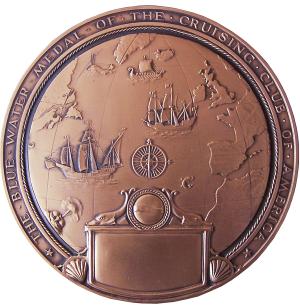For his meritorious ocean passages, his sterling seamanship and his advancement of the sport by counsel and example.
Without Date
Awarded "without date", signifying a particularly lengthy course of accomplishments at sea


The prestigious Blue Water Medal was inaugurated by the Cruising Club of America in 1923 to:
reward meritorious seamanship and adventure upon the sea displayed by amateur sailors of all nationalities, that might otherwise go unrecognized.
Blue Water Medallists have included such luminaries of the sailing world as Rod Stephens, Eric and Susan Hiscock, Sir Francis Chichester, Eric Tabarly, Pete Goss, Bernard Moitessier, and Sir Robin Knox-Johnston..
The Medal itself was designed by Arthur Sturgis Hildebrand, a member of the Cruising Club of America, who was one of the crew of the yacht Leiv Eiriksson, lost in the Arctic with all hands in September of 1923
For his meritorious ocean passages, his sterling seamanship and his advancement of the sport by counsel and example.
Awarded "without date", signifying a particularly lengthy course of accomplishments at sea
20,000-mile voyage of 50-year-old Bristol pilot cutter from England through Strait of Magellan, up west coast of South America, through Panama Canal and return to England, July 6, 1955-July 10, 1956.
Circumnavigation by Canal and Cape of Good Hope by owner and wife, July 24, 1952-July 13,1955 in 30-foot Giles-designed cutter.
A circumnavigation by Canal and Cape of Good Hope by owner and wife from Marstrand to Gothenburg, Sweden, between June 17, 1952, and June 22, 1954. A double-ended 33-foot ketch converted by owner and wife from a fishing boat.
A circumnavigation by owner and wife one other, plus dog, from Nice, France, to Zeebrugge, Belgium, July 7, 1951-August 2, 1953, via Canal and Cape of Good Hope. Steel 45-foot oa. gaff-rigged ketch. Said to be first steel yacht and first dog to circumnavigate.
A circumnavigation from and to New York via the two major canals in a 33-foot double-ended cutter. Single-handed, June, 1948-August 18, 1952.
From Honolulu around the Cape to New England, from Easter Sunday, 1948, to the spring of 1950. After the award the 39-foot oa., home-built Block Island type double-ended schooner completed her circumnavigation to Hawaii.
A cruise in a 50-foot ketch from Buenos Aires through the Mediterranean and to the Suez Canal and then to New York, following Columbus' route from Palos, Spain, to San Salvador.
From Honolulu to San Pedro, Calif., June 5, 1941- July 15, with one companion, on a 30-foot auxiliary ketch, 10-foot beam and 4 1/2-foot draft, designed by John G. Hanna. Orion carried on through the Panama Canal to Tampa, Florida, a total distance of 7978 miles.
The 1940 medal is different from all the others as it was awarded to a nation’s sailors for wartime mobilization of their largely amateur corps who participated in the rescue of Allied troops trapped on the beaches at Dunkerque.From the citation :Naval forces, fishermen, yachtsmen, ship yard workers, men of all callings left their shops or their desks, some without change of clothing and joined in this gallant effort to evacuate the apparently doomed army.Further: